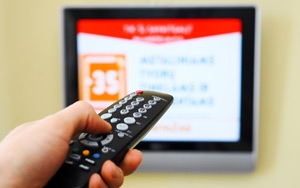Results from the ratings service’s new “code-reader” viewer measuring system that is set to replace the age-old paper diaries become available in June and what the data will look like is anybody’s guess. Uncertainty over the new system, its accuracy, its impact and its pricing appears widespread in the 14 markets where the new system is being introduced.
Will their ratings go up, down, or stay the same?
In a nutshell, that’s what broadcasters in 14 markets are anxious to find out as they await the arrival of the first sets of new data to be produced by the Nielsen “code-reader” viewer measuring system that is set to replace the age-old paper diaries.
The new data is almost here, due to be delivered in June to stations in the three markets where the system was first operational — Flint-Saginaw-Bay City, Mich. (DMA 70), Madison, Wis. (82) and Reno, Nev. (107) — and in July to stations in the remaining 11 markets where the system is also operational and undergoing testing.
What the data will look like is anybody’s guess. John Humphries, GM of Hearst Television's WGAL Harrisburg, Pa., an NBC affiliate, admits he’s apprehensive, but also optimistic. Harrisburg (DMA 45) is one of the 11 markets due to receive the so-called “impact data," designed to be compared with ongoing diary-based data, in July.
“Nielsen’s been measuring this market for 50 years [and] we also have done proprietary research over the years that use different samples and different methodologies,” Humphries said. “And Rentrak is in this market too. While we don’t subscribe [to Rentrak], we have seen some of those numbers.
“And every one of those independent research sources tells the same story about my station, so I would be shocked and, as you might imagine, disappointed if the new code reader methodology told a different story,” he said. “So, apprehensive, yes, but also optimistic that we’re going to retain our place in the marketplace.”
In addition to Harrisburg, the other second-wave markets are Grand Rapids-Kalamazoo-Battle Creek, Mich. (DMA 40); Fresno-Visalia, Calif. (54); Albany-Schenectady-Troy, N.Y. (58); Mobile, Ala.-Pensacola (Fort Walton), Fla. (59); Tucson (Sierra Vista), Ariz. (71); Paducah, Ky.-Cape Girardeau, Mo. (81); Charleston, S.C. (95); Traverse City-Cadillac, Mich. (118); Yakima-Pasco-Richland-Kennewick, Wash. (DMA 122); and Santa Barbara-Santa Maria-San Luis Obispo, Calif. (123).
Uncertainty over the new system, its accuracy and its impact appears widespread in the markets where the new system is being introduced. "We have been slow to embrace this next step for Nielsen,” said Chuck Roth, director of business administration for Quincy Newspapers, owner of ABC affiliate WKOW Madison.
The station only recently agreed to participate in the code-reader trial, Roth said. “There have been a lot of stops and starts and we have had concerns about how they were moving forward."
However, many of Quincy's concerns were addressed at a meeting with Nielsen executives at the NAB Show in Las Vegas earlier this month. "We left that meeting cautiously optimistic," Roth said. "We felt that they might finally be at the point where their code reader system might work. We felt fairly satisfied that they had a good plan on how they were going to deal with the demographics."
But it’s the demographic aspects of the new system that have raised the most questions among broadcasters.
The new Nielsen system consists of two parts. One is a new generation of passive code readers that track viewing in Nielsen households. The boxes, which are affixed to every TV set in a household, identify shows by “listening” to the audio and then identify the broadcasting station via a Nielsen “audio watermark” embedded in the signals.
Unlike Nielsen’s people meters, the passive code readers do not know which member or members of the family are doing the viewing, so demographic data is to be collected from both local and national people meters located in the closest larger markets and combined with the passive data from the code readers.
Nielsen believes this system of collecting demographic data – the other, second part of the system that Nielsen refers to as “viewer-assignment” data – will produce household demographic profiles that will closely resemble the demographics of the code-reader homes. Nielsen also intends to use the system to replace diaries for collecting demos in its 31 set-meter markets (DMAs 26-56). In those markets today, the hard-wired set meters generate the household ratings, while the diaries produce the demos.
Broadcasters’ reactions to viewer-assignment demos range from cautious to downright disbelieving.
Some broadcasters say they’re reserving judgment until they see the test data. Without the data, “it’s really hard to tell” if the viewer-assignment method is viable or not, said Billy McDowell, VP of research for Raycom Media.
But at least one owner of small-market TV stations — Bonten Media — recently dropped Nielsen in favor of Rentrak due to concerns over pricing, accuracy and the way Nielsen proposes to collect demographic data in smaller markets.
In an interview with TVNewsCheck posted Monday, Bonten CEO Randall Bongarten called the new demo-collection method “ridiculous.”
“They have come to this recognition that the demographic data in particular is extremely unstable and so what they’re going to do for these smaller markets is they are not even going to collect demographic data,” Bongarten said of Nielsen.
“So basically what they're doing is assuming that whatever the position is of the station in that bigger market is the position of the station in the smaller market. You’re applying the same exact demography. That’s ridiculous. It really doesn’t apply because the demography can vary with the strength or weakness of the individual station in that market,” Bongarten said.
“We went to Rentrak and I am extremely happy with them,” he said. “It’s a much more stable number, much larger sample, and we get ratings every day. It’s really, really superior to Nielsen and it’s a lot less expensive.”
Broadcasters say they’re uncertain about the costs of Nielsen’s new measurement system and are bracing themselves to be charged more than they’re paying now for paper-diary measurement. One station contacted by TVNewsCheck paid $12,000 for the encoder used to participate in Nielsen’s code-reader test.
“[Nielsen has] been very quiet about [pricing],” said one local broadcaster, Tom Bier, general manager of Morgan Murphy's CBS affiliate WISC Madison.
Nielsen wouldn’t comment on how it plans to price the new service. But Matt O’Grady, Nielsen’s EVP-GM of local media, expressed confidence that the data produced by the new measurement system would produce new revenue for stations. “We need to ensure that we deliver solutions to [stations] that they can afford and that accurately represent the market and bring more dollars into the market,” O’Grady said.
Whatever the costs, broadcasters seem to be hopeful that the new system will yield better data than the old one. “Generally speaking, we are looking at this as a good step for Nielsen. There has to be a better system than what they have today,” said Quincy’s Roth.
“I can’t [imagine] that this [would not] be much better, much more reliable [and] much more consistent,” WISC’s Bier said. “I think it’s going to serve the industry well when we get to that point.… Here in Madison, we are happy to be among the first adopters of this system.”

 First-quarter 2015 TV commercial ratings continue to sink this season.
First-quarter 2015 TV commercial ratings continue to sink this season. 


 A new biometric survey shows that traditional TV commercials are four times more engaging than video advertising on Facebook.
A new biometric survey shows that traditional TV commercials are four times more engaging than video advertising on Facebook. 

 Retail ad spending surged to end the quarter.
Retail ad spending surged to end the quarter.



 Traditional viewership for long-form video content, such as movies and television on a TV screen, has declined over the past year -- and not just with young viewers.
Traditional viewership for long-form video content, such as movies and television on a TV screen, has declined over the past year -- and not just with young viewers. 
 One bright spot: The 2016 Summer Olympics will lift spot revenues but those gains will be offset by declines elsewhere.
One bright spot: The 2016 Summer Olympics will lift spot revenues but those gains will be offset by declines elsewhere.